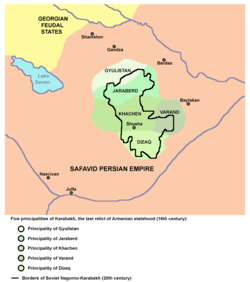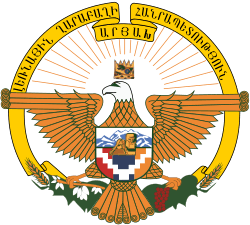Principality of Khachen
| Principality of Khachen | |||||||||
|---|---|---|---|---|---|---|---|---|---|
| 1261–1603 | |||||||||
 Royal Standard of the Principality of Khachen (Kingdom of Artsakh) during the reign of Grand Prince Hasan Jalal Vahtangian (1214-1261) | |||||||||
 Territory of the 5 principalities of Khachen, overlapped by the NKAO | |||||||||
| Capital | Gandzasar (Vank), Haterk, Tsar (Vaykunik) | ||||||||
| Common languages | Armenian | ||||||||
| Religion | Armenian Apostolic | ||||||||
| Government | Monarchy | ||||||||
| History | |||||||||
• Established | 1261 | ||||||||
• Disestablished | 1603 | ||||||||
| |||||||||
Part of a series on the |
|---|
| History of Artsakh |
 |
| Antiquity |
| Middle Ages |
| Early Modern Age |
| Modern Age |
The Principality of Khachen (Armenian: Խաչենի իշխանություն) was a medieval Armenian principality on the territory of historical Artsakh (present-day Nagorno-Karabakh).[1][2][3][4][5][6][7][8][9] The marches of Artsakh and Utik were attached to the Kingdom of Armenia in Antiquity. In the early medieval period where they were under Sassanid or Arab suzerainty until the establishment of the Bagratid Kingdom of Armenia in the 9th century.[10] From the 12th century the Armenian Khachen principality dominated the region.[10] The Byzantine emperor Constantine VII addressed his letters to the prince of Khachen with the inscription "To Prince of Khachen, Armenia."[11]
According to Abū Dulaf, an Arab traveller of the time, Khachen was an Armenian principality immediately south of Barda'a.[3] The Armenian princely family of Hasan Jalalyan began ruling much of Khachen and Artsakh in 1214.[12][13][14] In 1216, the Jalalyans founded the Gandzasar monastery which became the seat of a local Catholicos forced to Khachen from Partav (Barda) by the steady Islamization of the city.[10] The Khamsa (The Five) principalities maintained Armenian autonomy in the region throughout the Persian-Ottoman Wars. In 1603 the Persians established a protectorate over the Khamsa and sponsored the establishment of a local khanate in 1750.[10]
The name Khamsa, which was used by Arabs for the state, refers to the five Armenian Melikdoms who ruled the state.
See also
References
- ↑ Encyclopædia Britannica. Armenia:"A few native Armenian rulers survived for a time in the Kiurikian kingdom of Lori, the Siuniqian kingdom of Baghq or Kapan, and the principates of Khachen (Artzakh) and Sasun."
- ↑ C. J. F. Dowsett. The Albanian Chronicle of Mxit'ar Goš // BSOAS. — 1958. — Vol. XXI, No 3. —p. 482.:"Late name of part of pr. Arcax, forming at this time a small independent Armenian principality; the earliest references to Xacen are of the tenth century"
- 1 2 Abū-Dulaf Misʻar Ibn Muhalhil's Travels in Iran (circa A.D. 950) / Ed. and trans. by V. Minorsky. — Cairo University Press, 1955. — p. 74:"Khajin (Armenian Khachen) was an Armenian principality immediately south of Barda'a."
- ↑ Howorth, Henry Hoyle (1876). History of the Mongols: From the 9th to the 19th CenturyLongmans, Green, and Co. p. 14
- ↑ "Russian scholar V. Shnirelman: Khachen was a medieval Armenian feudal principality in the territory of modern Karabakh, which played a significant role in the political history of Armenia and the region in the 10th-16th centuries". В.А. Шнирельман, Албанский миф, 2006, Библиотека «Вeхи»
- ↑ "Russian scholar Smirnova L. P.: Armenian principality of Khachen in Karabakh". Аджаиб ад-дунья. Чудеса мира, ред. Смирнова Л.П., М. Наука. 1993
- ↑ "Armenian Khachen". Archived from the original on 2007-11-10. Retrieved 2007-10-23. Абу Дулаф. Вторая записка. Ред. Беляев В., М., Наука. 1960 (Комментарии) (in Russian)
- ↑ The New Encyclopædia Britannica by Robert MacHenry, Encyclopædia Britannica, inc, Robert MacHenry, (1993) p.761
- ↑ "Чудеса Мира, Предисловие, стр., 42". Vostlit.info. Retrieved 2012-05-06.
- 1 2 3 4 Parry, Ken; David J. Melling; Dimitry Brady; Sidney H. Griffith; John F. Healey (December 5, 2001). The Blackwell Dictionary of Eastern Christianity. Wiley-Blackwell. pp. 335–336. ISBN 0-631-23203-6.
- ↑ Constantine VII Porphyrogenitus, De ceremoniis aulae byzantinae (Ed. J.P.Migne. Patrologiae cursiis completus, Series Graeco-Latina, 112), p. 248, Greek: εἰς τὸν ἄρχοντα τοῦ Χατζιένης, Ἀρμενία.
- ↑ de Waal, Thomas (2003). Black Garden: Armenia and Azerbaijan Through Peace and War. New York: New York University Press. p. 287. ISBN 0-8147-1945-7.
- ↑ Hacikyan, Agop Jack; Gabriel. Basmajian; Edward S. Franchuk (2002). The Heritage of Armenian Literature: From the Sixth to the Eighteenth Century. Wayne State University Press. p. 470. ISBN 0-8143-3023-1.
- ↑ Cornell, Svante E. (2001). Small Nations and Great Powers: A Study of Ethnopolitical Conflict in the Caucasus. Routledge (UK). p. 66. ISBN 0-7007-1162-7.
External links